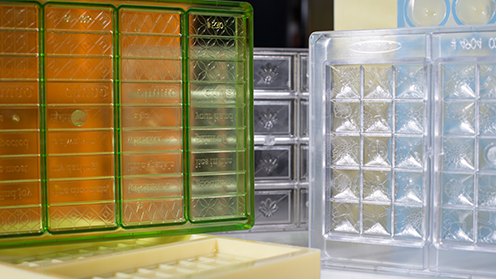First let’s demystify the term polycarbonate. Polycarbonate is a type of plastic, not a method of construction or manufacture. Therefore even if polycarbonate plastic is used in the vacuum/thermoforming process they will still possess most of the shortcoming of the vacuum/thermoforming process. Just because it is made with polycarbonate plastic or called a "polycarbonate mold" doesn’t make it a high quality Micelli injection molded polycarbonate chocolate mold. Be informed – ask specifically for "injection molded" polycarbonate chocolate molds.
Mold Attributes
Injection Molded Molds
Vacuum/Thermoformed Molds
Why This Is Important
Top Surface
Rigid Flat Top Surface
Unstable Inconsistent Top Surface
Scrapping Top Surface
Sides / Structure
Rigid Side Construction
Flimsy/Wobbly
Cleaning Sides
Vibration Transfer to Chocolate
Excellent Vibration Transfer
Absorbs Instead of Transferring Vibration to Chocolate
Minimize Air Bubbles
Surface Finish
High Quality Surface Finish
Inconsistent Surface Finish
Chocolate Appearance
Engraving Details
Very Fine Details Possible
Details Impacted by Plastic Thickness
Legibility of Logo or Art
Mold Life
Extremely Durable
Replacements Unlikely for Artisans
Breakage Extremely Rare for Artisans
Inferior Durability, Breakage is Common
Replacement Orders are Quite Common
Poses a Potential Risk
Avoid Mold Breakage
Avoid Replacement Orders
Avoid Plastic Contamination
Mold Warming
Accepts Repeated Heating/Cooling
Lower Tolerance for Repeated Heating/Cooling
Maintain Temper
Potential Automation
Suitable for Automatic Molding Lines
Suitable for Magazine Loaders
Not Suitable for Automatic Machinery
Not Suitable for Automatic Magazines
Flexibility for Future Growth
Washing
Suitable for Automatic Washing
Higher Temps/Pressure Possible
Limited Use in Automatic Washers
Limited Resistance to Warpage
Reduced Labor
Improved Sanitation

High Quality Polycarbonate Injection Molds by Micelli
Injection Molding Process
- Injection molding is used to produce the most sought after molds for specialty Artisans chocolatiers and bean to bar manufacturers.
- Plastic polycarbonate pellets are melted at very high temperature above 500 degrees F.
- Molten plastic is injected in liquid form into a 2 part steel/alloy metal die under extreme pressure (upwards of 20,000 PSI).
- Finished molds ejected from the steel mold and are a rigid, stable, extremely durable product.
- Plastic type is exclusively polycarbonate in our injection molding process for chocolate molds.
- Advantages- Very fine details, sharp images, superior surface finish & textures, rigid flat top surface, longest mold life(avoids replacements), ability to be used on automatic depositors/molding lines, washable in dishwashers /industrial washers.
Injection Molding Vs. Vacuum Forming - Watch Video Above!
Vacuum/Thermoforming Process
- This is a process of manufacturing that is used to produce lower grade chocolate molds, prototype molds or molds for the craft industry.
- Plastic starts as a sheet and is suctioned over a positive die under relatively low pressure 15 to 60 psi.
- Plastic type can be PET or polycarbonate.
- Disadvantages — unstable inconsistent surfaces, not flat/wavy top and sides, not sturdy/rigid, much shorter mold life, limited detail, inferior surface finish, low rigidity, low tolerance for repetitive heating/cooling cycles.